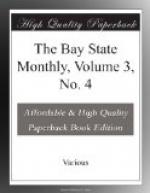Immediately after the execution, the body of the martyr was borne to North Elba, N.Y., and, on the 8th of November, 1859, it was laid away to rest. Mr. Sanborn gives only the briefest account of these last services, and omits, for some unaccountable reason, to furnish even an extract from that pathetic and pointed address, which came from Wendell Phillips, while standing by the open grave. If Mr. Phillips ever spoke more beautifully than he did, on that memorable day, we have never known it. We sincerely hope that, in a future edition, Mr. Sanborn may be led to insert the address in the pages where they so properly belong.
[Footnote 6: The Life and Letters of John Brown, Liberator of Kansas, and Martyr of Virginia. Edited by F.B. Sanborn, Boston: Roberts Bros. Price, $3.00]
* * * * *
The theme of Prof. Hosmer’s narrative[7] was born in Boston. Sept 27, 1722, and graduated at Harvard in 1740, and studied law. He was not a lawyer and neither did he make his mark as a merchant although he engaged with his father in the management of his malt-house. This early life of Samuel Adams is portrayed with more than usual interest in this biography. Then with great care we are given the salient points of his career as a representative in the Massachusetts General Court, as a leader of the Boston patriots in their resistance to British oppression, as a member of the Continental Congress and in other public offices. We are shown Samuel Adams as a man without great business or professional talents but wonderful in counsel, a cool headed patriot, an adroit tactician, and above all a thorough democrat. To mingle with the common people was his delight; he was a frequenter of the Caulkers’ Club, popular with blacksmiths, ship carpenters, and mechanics. He was not a great orator; but sometimes, rising with the greatness of the subject or occasion was the most effective speaker to be heard.
The two features of Professor Hosmer’s work which impress us most forcibly are its fairness and its readableness. We have had one worthy life of Adams before this in Wells’s three volume biography, a work highly valuable in its abundance of matter, but hardly so impartial as the smaller and more recent biography. In its preparation, Professor Hosmer has availed himself of Mr. Wells’s work, of the Adams Papers in Mr. Bancroft’s possession, and of copious materials in the Boston libraries. He has thus had every facility for his task and he has used them to the best advantage.




